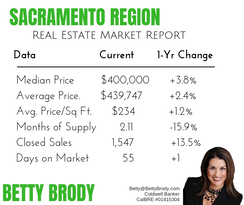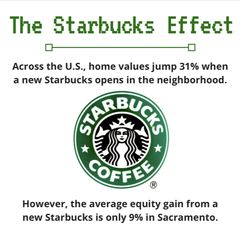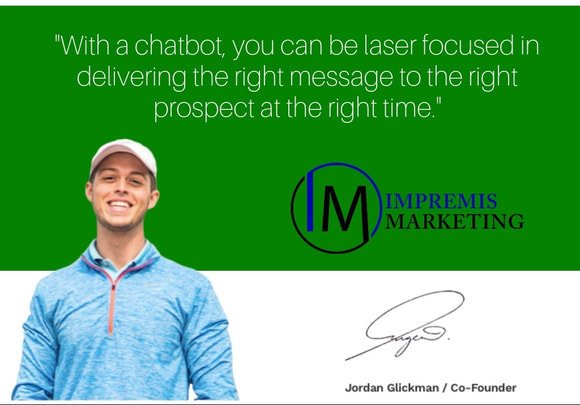|
Every business owner or entrepreneur is looking for an edge. We're all seeking that next big technique, platform, or strategy that will help us reach a wider audience, boost sales, and vastly improve our bottom line. That's especially true if you work in the ultra-competitive arenas of real estate or mortgage lending, where any new technology could put you months or even years ahead of your competition. But, it's just as important to have a cutting edge marketing plan if you're a CPA, financial planner, insurance agent, or sell any product or service. Chatbots in the burgeoning field of Artificial Intelligence do exactly that, offering a clear advantage and ultra-efficient way to engage new clients. So, today, I'm super excited to give you a great introduction to chatbots, the marketing tech of today! Is Artificial Intelligence real? Yes, but we’re not talking about the Terminator kind of Artificial Intelligence (AI). Instead, AI is defined as any self-directed technological process, appearing to “think” for itself. A closer look at chatbots Chatbots are one kind of AI that’s growing increasingly common these days. In fact, more than 15,000 companies and brands in the U.S now utilize chatbots, with those numbers are growing every day. They can be programmed for use on a website or app like Facebook Messenger and Instagram (by the end of 2019), effectively respond and react to a plethora of situations, inquiries, or cues. “Having a chatbot means that your clients and prospects will always get immediate, personalized service and answers to their questions." says Jordan Glickman, founder of North Carolina-based Impremis Marketing. “In this on-demand economy, you can’t afford to let a prospect go elsewhere for information or wait around for you to get back to them. Therefore, chatbots are like the perfect employees who work 24-7, never call in sick, and never are late!” How chatbots generate leads As a Realtor, mortgage broker, or any small business owner, finding and converting leads is the lifeblood of your success. Chatbots are an incredibly efficient way to funnel traffic from a website, Facebook ad, or email campaign, turning visits into qualified leads – with none of your time or effort. When someone comes to your Facebook page, for example, the chatbot will initiate a conversation with the viewer via a pop-up message. The ‘bot will then answer their questions with pre-determined scripts and proposing questions or encouraging classification that narrows down the visit by certain criteria. Of course, you can program your chatbot to filter by certain criteria or focus on any specific Call-to-Action you wish, including post-sale follow-up and garnering testimonials and reviews. It's important to note that they don't replace human contact, but start a basic conversation with your prospect, pre-qualifying them as to their needs, desires, timelines, and other valuable information. Then, the chatbot system hands all of that to you on a silver platter when it's time for "human takeover" as it's called in the business, whether that's a phone call, a meeting scheduled at your office, an invite to an event or seminar, or even an open house How can chatbots prequalify your prospects? For instance, a chatbot can ask a visitor if they are looking to buy a house or sell a house. If they answer affirmatively to one of these two, the bot can then ask how soon they are looking to make this purchase/list their home/ if they've been pre-approved by a lender/ if they've signed with a listing agent yet/etc. The bot can even schedule an appointment or phone consultation based on their responses. So, by the time you receive an alert, all of this information has been gleaned and the visitor pre-qualified as a lead. Chatbots also provide value to visitors by answering FAQs, directing them to certain pages of your website or other resources, and more. Visitors who are determined to not be qualified prospects at the time aren't abandoned or lost in the shuffle. Instead, they can be assigned to categories for follow-up marketing campaigns like re-targeting, education emails, guides or informational reports they can download, and scheduled for a check-in down the road. Chatbots as part of your marketing funnel The key to making a chatbot work effectively is funneling a large number of people to your webpage, Facebook, Instagram, or email marketing campaign. They work best when integrated into some sort of paid ad or promotion that garners a significant number of visitors who can then be narrowed down into qualified leads . “Chatbots are a far more efficient way to market compared to traditional methods like handing out flyers or expensive mailers," says Glickman. "With a bot, you can be laser focused in delivering the right message to the right prospect at the right time. We routinely see 85% open rates and 60% click-through rates with our messages and emails using chatbot systems, which blow industry averages out of the water.” Chatbots actually personalize the process
On the user end, they realize that they're "speaking" with an automated process, not an actual human being. However, you'll find that chatbots aren't cold, soulless automatons, but actually add personalization and foster human interaction. You’re encouraged to preset your chatbot’s responses based on your personality, how you speak, and even have some fun with it. Chatbots will also set you up for far more phone calls or face-to-face meetings than a plain website, email, or Facebook page, adding to the human connection. Chatbots will help build and deepen relationships with your audience! Benefits to using a chatbot: 1. Turn prospects and visitors into qualified LEADS, LEADS, LEADS! The huge, compelling benefit to using a chatbot is seeing qualified hot leads popping up in your email, smartphone, and on your schedule. 2. Attract and engage a younger audience. This includes Millennials, who are comfortable interacting with technology and apps, and constitute massive online spending power. 3. Gather data. Collect your visitor's name, phone number, email, age, birthdate, homeownership status, and a host of other demographic and lifestyle data through chatbots – all valuable information to qualify your audience. 4. Build a larger audience Gain subscribers, likes, followers, and add to your email list, etc. 5. Save time - and a whole lot of money. You can provide instant, personalized service 24/7, never leaving a potential client waiting for answers or help, all without hiring employees or answering services. 6. Exponentially increase the ROI of your ads Most businesses and entrepreneurs are using paid Facebook or Instagram ads these days or other pay-for-play web techniques (or, you should be!). But, it's awfully reactive to pay for an ad and just hope for the best. Instead, funneling these ads to a website or Facebook page with a chatbot will exponentially increase the effectiveness of those ads, boosting ROI. So, what does it take to set up a chatbot (and how much does it cost)? Just about any brand or business can see the benefits of a chatbot, which is really marketing technology of the future in its first phase of mainstream development today. To get started, consider having a bot set up on your website but definitely on your business Facebook page and soon, your Instagram account. Of course, you’ve probably been wondering about the cost of chatbots since the opening line of this article! Designing, building, and implementing a fully-customized chatbot can range from hundreds on the low-end to thousands for most brands and entrepreneurs, and more for bigger and more complex business systems. While that's significant, if you're in real estate, mortgage lending, financial services, or sell any big-ticket item, that's probably far less than what you'll earn when you attract your first client using that chatbot! Can I see a chatbot in action? For a demonstration of what a chatbot may look like for a real estate agency website or Facebook page, check it out here. And if you have any questions or would like more information to get started, you can drop me a line or contact Jordan Glickman of Impremis Marketing. I promise you that he’s a real live human being! Your friend, -Norm :-)
0 Comments
Do you remember the early 80s song, “Video called the radio star?” Well, some people may think that video marketing has killed the blogging star these days, but that’s actually not true. In fact, posting a blog on your website and sharing it on social media and via email is still a valuable and essential marketing tool. Studies show that people not only trust blogs more, but look to blogs for information and recommendations before making a purchase (like a home or a home loan!). These blogs can be short (and optimized for reading on mobile devices), but, basically, if they're not getting this information from you, they're reading it on your competitor's blog or website! Since 2011, I estimate that I’ve written about 3,500+ blogs and articles for Realtors, mortgage lenders, and small business owners, along with countless social media posts sharing this content. Part of my job is also keeping track of analytics, so I measure how many people are clicking, reading, and reacting to these blogs. Based on that experience, I put together this list of the TOP PERFORMING BLOG TOPICS for any real estate agent. I’ve noticed what works best for Realtors and gets the most reaction from their audience, time and time again. I’ve even formulated a scoring system based on total number of page views, clicks, likes, comments, sharing, and other engagement metrics. You’ll see that I rated each blog with this engagement score, just for purposes of comparison. If you want likes, followers, inquiries, and a fast-growing database, go down the list and offer these blogs via your professional social media accounts, emails, newsletters, on your website, and other marketing. Written and crafted correctly, these blogs will yield the results you want: more leads, clients, and, ultimately, closed deals! And if you're not a Realtor but a mortgage lender, financial planner, CPA, or any other small business owner, contact me for the list of top-performing blog posts in your field! The top-10 performing blog topics for Realtors:  1. Neighborhood profiles Home buyers aren’t just interested in a brick and mortar structure, but the lifestyle that their new home affords them. Therefore, blogs and profiles on certain neighborhoods score remarkably well with real estate audiences, who are looking to compare locations as much as houses. In these neighborhood-centric blogs, you can cover a brief history, what it’s best known for, restaurants, parks and recreation, festivals and events, typical architecture, nearby amenities, commute times, and staple mom-and-pop businesses. Yes, you should also cover real estate market data and recent home prices. Tip: You can even document famous people from that area, local trivia, and other interesting facts, but there are a few things that you CAN’T mention in these blogs (see below). Blog engagement score 96%  2. Pointing out common mistakes (negative-slant themes) What are the 10 mistakes first-time homebuyers make? What 5 mistakes are costing sellers big bucks? Why should you definitely avoid these landlord mistakes with your new rental properties? Research shows that the human motivation to AVOID PAIN (in this case, usually wasting money but also time, energy, liability, etc.) is even stronger than our motivation to pursue GAIN. For that reason, blogs with a. negative spin, i.e. what NOT to do, or which mistakes NOT to make, perform surprisingly well with audiences. Tip: Don’t be afraid to hit ‘em with the truth, because this is your one chance to scare your audience a little bit - for their own good and to be helpful. Blog engagement score 92%  3. Local market update (including home values) Do you specialize in a certain neighborhood, or have a marketing campaign “farming” a specific area? You should exhibit to your audience that you’re the authority on the matter, offering up-to-date and accurate data on home values, buying and selling information, and other pertinent housing and economic data. Tip: I recommend drafting a Special Report every quarter with local housing data and emailing it out. The key is to make it as predictable and consistent as clockwork so your audience grows to look for it!. Blog engagement score 89%  4. How to make more money Did I catch your attention already? Home ownership is the most significant lifetime investment for most consumers, so a lot is riding on getting it right. In fact, just by knowing how to fix up your home before selling, whether to stage or not, or knowing if it’s the right time to sell could put tens of thousands of extra dollars in your sellers' pockets. And for buyers, their choices are just as critical, so any information that helps inform and guide them towards a great home that will appreciate exceedingly well is invaluable. Tip: Be specific. While “How to make more money when selling your home,” is fine, a blog with the title “How to increase your net profit by 1.5% in 3 easy steps when selling your home” will practically jump off the page at the reader (or jump off the computer screen.) Blog engagement score 87%  5. How-To’s Consumers are always looking for sound, fundamental information about home buying, selling, and just about everything else when it comes to real estate and home loans. First-timers, in particular, find this extremely valuable. So, keep writing those stupid-simple guides to buying a home, house hunting, investing, the escrow process, and getting a mortgage. Tip: Set these up as a easy-to-skim list based on FAQs, add a few graphics, and save it as a PDF so it's a information report that you can easily send out to clients and potential clients. ***
Look for part two of this blog coming soon, where I'll cover the next 5 top-performing blog topics for Realtors. And you can always contact me for help or just to chat about your marketing! Your friend, Norm :-) Imagine if you had your name, company name, and even an authoritative quote featured in a news article. What kind of (free) exposure would you enjoy if you were the go-to Realtor/Mortgage Lender/Business Owner for your local media outlets? What would it be worth if you were routinely mentioned, quoted, or even invited live to television shows, radio programs, and in newspaper and magazine articles? It's easier than you may think to get press coverage that reaches hundreds, thousands, or, potentially, tens of thousands of people – all without paying a cent in advertising. In fact, writing and distributing a press release is one of the most underutilized promotional tools for real estate professionals or any business owner, yet so few do it. Of course, I know why more people don’t send out press releases. If you don’t know how to properly write and send them out, it can be confusing, a little intimidating, or just a waste of time. So, in this blog, I’ll walk you through the right way to write a press release that will look like a PR expert drafted it. First off, I wanted to give you some examples of topics for a press release: XYZ real estate office grand opening. Home sales heating up in CITY NAME. Free homebuying workshop offered in CITY NAME. XYZ Mortgage gives back to community with day of service. Buying a home may be more affordable than renting in CITY NAME. Home values in CITY NAME now back to pre-recession levels. How to pick the right neighborhood when buying a home. Home fire safety tips. NAME honored with award/promotion/inclusion on list, etc. The options are abundant, as long as you remember that it has to be about something specific, tangible, and of value to the audience – not just self-promotion for its own sake. But remember that it doesn’t need to be YOUR statistic, data, or happening for you to write and send in a press release. It can be about anything in your field of real estate, mortgage, or whatever field your business operates in, as long as it’s credible, fits that media’s editorial needs, and within their scope. (Don’t send in a press release only about Sacramento to a national magazine, etc.) It’s also imperative that you structure it as a press release from the title all the way to the end, which I’ll break down for you now: What is a press release? A press release is an official announcement issued by a company, agency or organization that’s distributed to the news media. Press releases are sometimes also called a “press statement,” a “news release,” or “media release.” These releases disseminate the information necessary for one potential news story or important happening. What ISN’T it? A press release is not an advertisement. It’s not a commercial, a bio, an interview, a general informational piece, or a personal profile. Press releases are not subjective, opinion without factual basis, or written to sway or persuade the reader. How long should it be? Press releases are usually just one page long on a printed page, but they should never surpass two pages in length. These days, most press releases are sent via email, but you should still aim to be succinct. The goal is to provide enough information for the media outlet to write their own notice, announcement or news story, so 400-600 words is an ideal target range for an unsolicited release. To keep it short, provide links to your website, blog, or how they can contact you if they would like to learn more. Header The press release starts with a header, including the always-present tag line in capital letters stating, "FOR IMMEDIATE RELEASE." The header also contains the contact information for the person that can be reached for more information (name, email and phone number) as well as the date of the release. The FOR IMMEDIATE RELEASE and date are always left justified, while the contact information is right justified. Headline Immediately after the header, you'll find the headline (don't get those two confused!), which serves as a bold announcement to get the reader's attention and succinctly tell them what the release is about – all in eight words or less. But headlines don't need to be full sentences, although they should be written in present tense (even though the rest of the press release is written in past tense) with clear, direct language and action verbs. Dateline and lead After the headline, you’ll find the dateline. The dateline is the city name in capital letters, followed by the state abbreviation in most cases, and then a dash. Next up is the lead, which acts a subheader, expanding on the important points of the release for the reader – all within 32 words. The body This is the meat and potatoes of the press release, so cover the Who, What, When, Where, How, and What’s Next of your statement in the body. Share this information directly and clearly, without elaborate or flowery language. If you start using words like “super,” “special,” “best,” “amazing,” or even “very,” the media contact reading it will know right away that you’re an amateur just looking to promote their business. First paragraph In the first paragraph of the body, always answer the question, “Why should they (the media contact and their readers) care?” It’s a good idea to include a direct link to your company’s website in the first paragraph of the body, as well as cite data, statistics or other references with their corresponding links. Statistics, data, and facts about the real estate market, local sales, mortgage markets, buyers or sellers, etc. are great to share, so make sure they are clearly featured. Quote Good quotes humanize the information and also add credibility.So, round-out the information you're trying to convey with a quoted statement. Every press release should have at least one quote; two is ideal, but you should never have more than three quotes. Quotes can come from a credible source like the company president, happy client, official or agency, or another third party that's involved. Of course, this is the ideal place to submit your own quote, offering some sage advice and key takeaways. THIS is the best way to get your name injected into the news story and shared widely in the media! Background info The last paragraph of the press release doesn’t focus on the story or the relevant announcement but adds some background and supporting information for the reader to put in context. This can be a little bit about the sender/company (the Realtor/Mortgage Broker/Business Owner and their service), and even the field. You can also cover how you are different and future trends or next steps the reader should be aware of. ### Three pound signs are placed at the bottom of a press release, signaling to the reader that they've reached the end of the document (and that they aren't missing any pages.) Sometimes you'll also see "End" instead of these three pound signs to conclude the release. Speaking of end, that's all for today! Oh, I almost forgot... ###
|
Categories
All
Archives
December 2020
|
Get in touch: |









 RSS Feed
RSS Feed
